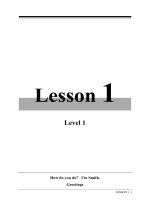HOW DO VITAMINS WORK
Bạn đang xem bản rút gọn của tài liệu. Xem và tải ngay bản đầy đủ của tài liệu tại đây (31.77 KB, 2 trang )
HOW DO VITAMINS WORK?
A, C, E, D, B, K. No, this isn’t some random, out of order alphabet. These are
vitamins and just like letters build words, they’re building blocks that keep the
body running. Vitamins are organic compounds we need to ingest in small amounts
to keep functioning. They’re the body’s builders, defenders, and maintainance
workers, helping it to build muscle and bone, make use of nutrients, capture and
use energy and heal wounds. If you need convincing about vitamin value just
consider the plight of olden day sailors who had no access to vitamin-rich fresh
produce, they got scurvy. But vitamin C, abundant in fruits and vegetables, was a
simple antidote to this desease. While bacteria, fungi, and plants produce their own
vitamins our bodies can’t, so we have to get them from other souces. So how does
the body get vitamins from out there into here? That is dependent on the form these
compouds take. Vitamins come in 2 types: lipid-soluble and water-soluble. And the
difference between them determines how the body transports and stores vitamins
and gets rid of the excess.
The water-solubles are vitamin C & B complex vitamins that are made up of 8
different types that each does something unique. These are dissolved in the watery
parts of fruits, vegetables and grains, meaning their passage through the body is
relatively straightforward. Once inside the system, these foods are digested and the
vitamins within them are taken up directly by the bloodstream, because blood
plasma is water-based. Water-soluble vitamins C & B have their transport cut out
for them and can move around freely within the body.
For lipid-soluble vitamins, dissolved in fat, and found in foods like dairy, butter
and oils. This trip into the blood is a little more adventurous. These vitamins make
it through the stomach and the intestine where an acidic substance called bile flows
in from the liver, breaking up the fat and preparing it for absorption through the
intestinal wall. Because fat-soluble vitamins can’t make use of the blood’s watery
nature, they need sth else to move them around and that comes from proteins that
attach to vitamins and act like couriers, transporting fat-solubles into the blood and
around the body. So this difference between water and fat-soluble vitamins
determines how they get into the blood but also how they’re stored and rejected
from the body. The system’s ability to circulate water-soluble vitamins in blood
stream so easily means that most of them can be passed out equally easily via the
kidneys. Because of that, most water-soluble vitamins need to be replenished on a
daily basis through the food we eat. But fat-soluble vitamins have staying power
because they can be packed into the liver and in fat cells. The body treats these
parts like a pantry, storing the vitamins there and rationing amount when needed,
meaning we should not overload on this types of vitamin, because the body is
generally well stocked. Once we figured the logistics of transport and storage, the
vitamins are left to do the work they came here to do in the first place. Some, like
many of the B complex vitamins make up coenzymes, whose job it is to help
enzymes release the energy from food. Other B vitamins then help the body to use
that energy. From vitamin C you get the abality to fight infection and make
collagen-a kind of tissue that forms bone and teeth and heal wounds. Vitamin A
helps make white blood cells- key in the body’s defence, helps shape bones and
improves vision by kepping the cells of the eye in check. Vitamin D gathers
calcium and phosphorus so we can make bones. Vitamin E works as an
antioxidant, getting rid of elements in the body they can damage cells. Finally,
from vitamin K we score the ability to clot blood since it helps make the proteins
that do this job.
Without this vitamin variety, humans face deficiencies that cause a range of
problems like fatigue, nerve damage, heart disoders or deseases like rickets and
scurvy. On the orther hand, too much of any vitimin can cause toxicity in the body
so there goes the myth that loading yourself with supplements is a great idea. In
reality, it’s all about getting the balance right and hitting that vitamin jackpot.
Hit the jackpot = to make or win a lot of money quickly and unexpectedly (bất
ngờ)









